【英语】巴菲特介绍(课堂PPT)
- 格式:ppt
- 大小:5.43 MB
- 文档页数:20

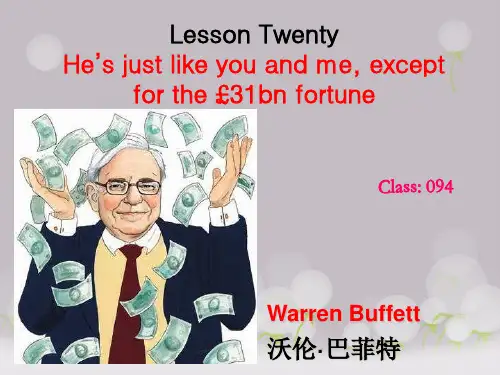
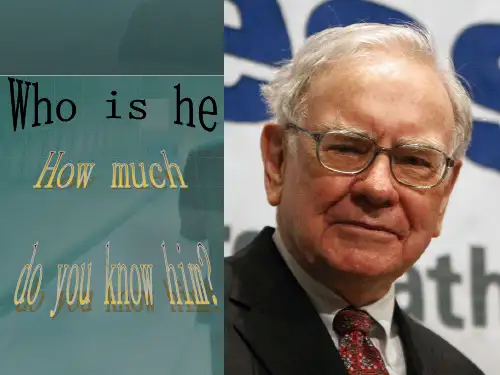
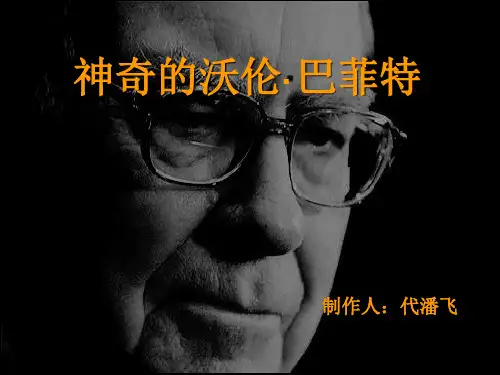
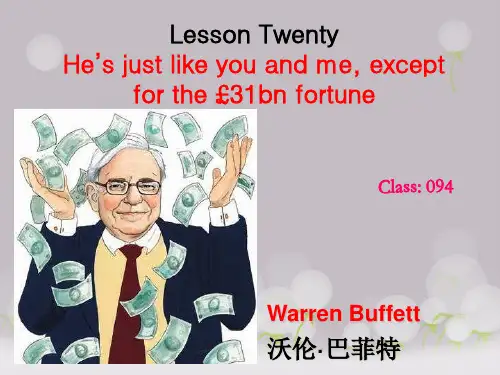
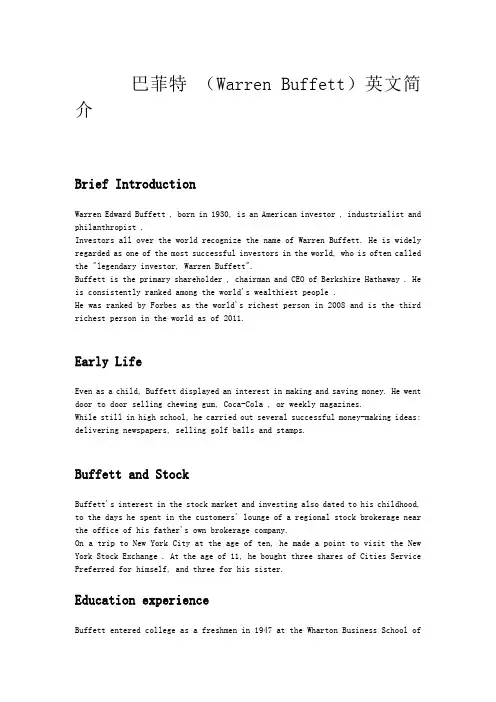
巴菲特(Warren Buffett)英文简介Brief IntroductionWarren Edward Buffett , born in 1930, is an American investor , industrialist and philanthropist .Investors all over the world recognize the name of Warren Buffett. He is widely regarded as one of the most successful investors in the world, who is often called the "legendary investor, Warren Buffett".Buffett is the primary shareholder , chairman and CEO of Berkshire Hathaway . He is consistently ranked among the world's wealthiest people .He was ranked by Forbes as the world's richest person in 2008 and is the third richest person in the world as of 2011.Early LifeEven as a child, Buffett displayed an interest in making and saving money. He went door to door selling chewing gum, Coca-Cola , or weekly magazines.While still in high school, he carried out several successful money-making ideas: delivering newspapers, selling golf balls and stamps.Buffett and StockBuffett's interest in the stock market and investing also dated to his childhood, to the days he spent in the customers' lounge of a regional stock brokerage near the office of his father's own brokerage company.On a trip to New York City at the age of ten, he made a point to visit the New York Stock Exchange . At the age of 11, he bought three shares of Cities Service Preferred for himself, and three for his sister.Education experienceBuffett entered college as a freshmen in 1947 at the Wharton Business School ofthe University of Pennsylvania and studied there for two years from 1947 to 1949. In the year 1950, when he entered his junior year, he transferred to the University of Nebraska–Lincoln where at the age of nineteen, he graduated with a degree of Bachelor of Science in Business Administration.After the completion of his undergraduate studies, Buffett enrolled at Columbia Business School after learning that Benjamin Graham (author of " The Intelligent Investor " – one of his favorite books on investing) and David Dodd , two well-known securities analysts , taught there.He received a MS in Economics from Columbia Business School in 1951. Buffett also attended the New York Institute of Finance .WealthIn 2008 he was ranked by Forbes as the richest person in the world with an estimated net worth of approximately US$62 billion .In 2009, after donating billions of dollars to charity, Buffett was ranked as the second richest man in the United States with a net worth of US$37 billion with only Bill Gates ranked higher than Buffett. His net worth is up to $47 billion in the past 12 months.PhilanthropyBuffett is also a notable philanthropist.In June 2006, he announced a plan to give away his fortune to charity, with 83% of it going to the Bill & Melinda Gates Foundation .He pledged about the equivalent of 10 million Berkshire Hathaway Class B shares to the Bill & Melinda Gates Foundation, making it the largest charitable donation in history, and Buffett one of the leaders of philanthrocapitalism .Buffett’s WordsWhat counts for most people in investing is not how much they know, but rather how realistically they define what they don't know. An investor needs to do very few things right as long as he or she avoids big mistakes.就投资而言,人们应该注意的,不是他到底知道多少,而是应该注意自己到底有多少是不知道的,投资人不需要花太多时间去做对的事,只要他能够尽量避免去犯重大的错误。



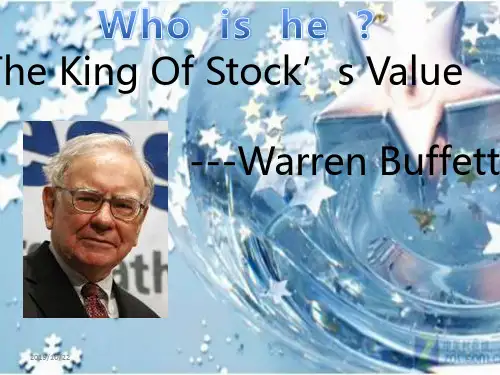
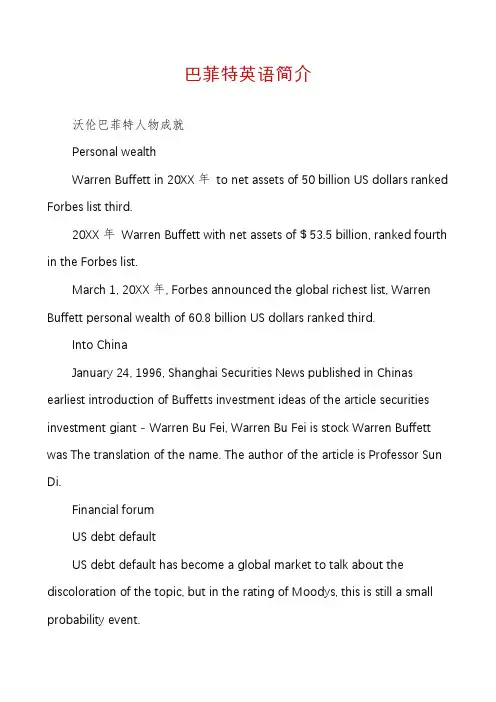
巴菲特英语简介沃伦巴菲特人物成就Personal wealthWarren Buffett in 20XX年to net assets of 50 billion US dollars ranked Forbes list third.20XX年Warren Buffett with net assets of $ 53.5 billion, ranked fourth in the Forbes list.March 1, 20XX年, Forbes announced the global richest list, Warren Buffett personal wealth of 60.8 billion US dollars ranked third.Into ChinaJanuary 24, 1996, Shanghai Securities News published in Chinas earliest introduction of Buffetts investment ideas of the article securities investment giant - Warren Bu Fei, Warren Bu Fei is stock Warren Buffett was The translation of the name. The author of the article is Professor Sun Di.Financial forumUS debt defaultUS debt default has become a global market to talk about the discoloration of the topic, but in the rating of Moodys, this is still a small probability event.The Treasury Department is unlikely to pay due Treasury bonds, said Moodys chief executive Raymond McDaniel. I hope the debt ceiling will increase on the 17th, but if not, I think the Treasury will continue to honor its commitments.Today, the United States democracy, the Republican Party war has been burned to the US debt, October 17, 20XX年, the United States will usher in the debt ceiling test.This (if the US debt default) is like a nuclear bomb explosion, the consequences are simply unimaginable. Buffett last week in the Fortune magazine interview said.EconomyBuffett said there is no doubt that the global economy is slowing, but the United States is slightly better than Europe.At the same time, Buffett also said the US housing market has been rotated, with the housing market recovery, housing-related companies will benefit, such as furniture and carpet industry. Buffett revealed that he took advantage of Wells Fargo shares fell, in the past week to buy more of the stock. In the past month, Wells Fargo shares fell more than 3%.As of June 30, 20XX年, Berkshire Hathaway reported that it held more than 411 million shares worth nearly $ 14 billion. Buffett said it was not enough and would keep buying.Buffett believes that the bank is still a very good industry, but thebank crisis before the credit crisis is not profitable. Buffett said he was interested in buying some of the companys prospects in 20XX年, when two potential $ 20 billion acquisitions were blown by price issues.Berkshire Hathaway has $ 40 billion in cash, but the price is unreasonable, and Berkshire Hathaway will not join the bid. He plans to target a $ 6 billion financial company, but he does not mention that it is a potential acquisition.Buffett reiterated his long-held view that the stock market is the best funding for investment, and expressed confidence in IBMs long-term prospects.In 20XX年, Berkshire Hathaway bought about $ 11 billion in IBM shares, and Buffett said it would also jiacang to that level. As for Berkshire Hathaway holding another big stock Procter Gamble, Buffett admitted that in recent years the profitability is really poor.But Buffett praised the chairman and chief executive officer Bob McDonald is an outstanding figure. MacDonalds leadership is popular today. Buffett said Berkshire Hathaway had sold some Procter Gamble stock.Buffett also expressed strong support for Federal Reserve Chairman Ben Bernankes third term, saying that Bernankes job was excellent, and that no one was better qualified for the Feds position. Buffett believes that if the president made an invitation, Bernanke will agree to re-election.However, Buffett said he was worried about the Feds expanding balance sheet. His intuition should be against the Feds QE3 economic stimulus plan. At the same time, Buffett believes that the United States is very likely in the short term out of the financial cliff risk.Taxation point of viewAugust 20XX年, the famous US investor Warren Buffett local time on the 15th that the richest Americans should pay more income tax, to improve the countrys financial situation to contribute.Buffett said in the New York Times entitled stop pet super rich article said that the poor and middle-class Americans in Afghanistan for the country to fight, and such a rich but still enjoy Special tax concessions. One of the main manifestations of the distribution of injustice is that the capital is too much in the distribution, and that the labor is too much in the distribution.Buffetts 15th in the New York Times article is thoughtful. The title of the article is stop spoiled the rich, the signs directly to the rich. Some people will say that Buffett is not deliberately to please President Obama, non-also, whether it is wealth or age, he does not need to please anyone and any power. This is Buffetts consistent style and thought. This passage is equally worthy of the richness of the Chinese people.沃伦巴菲特荣誉In the 20XX年Forbes list of wealth over Bill Gates, become theworlds richest man. In the eleventh charity fund-raising, Buffetts lunch auction to 2.63 million US dollars.In July 20XX年, Warren Buffett once again donated shares to five charities, according to the current market value equivalent to 1.93 billion US dollars. This is the third highest contribution since Buffett began to donate 99% of its assets in 20XX年.February 15, 20XX年, access to the symbol of the highest honor of the United States of America Medal of Freedom.March 10, 20XX年, 20XX年Forbes Global Regal list released in New York, Buffett to worth 50 billion ranked third.March 26, 20XX年, Barron Weekly online version of the 20XX年global 30 best CEO, ranked third.In December 20XX年, Buffett announced that his son Howard would play the role of heir in Berkshire Hathaway.April 20XX年, suffering from prostate disease, has not yet threatened life.20XX年Forbes wealth list to $ 53 billion ranked fourth.February 28, 20XX年, Hurun Global Rich List, Buffett ranked second.March 2, 20XX年, Forbes released 20XX年global richest list.Among them, the top three were Bill Gates, Carlos Slim, Warren Buffett, wealth were $ 79.2 billion, $ 77.1 billion and $ 72.7 billion.In mid-July 20XX年to the end of August, Buffetts BerkshireHathaway company in the investment stock market has at least a loss of $ 11.2 billion book. The equivalent of Berkshire Hathaway has shrunk by 10.3%.In 20XX年, the worlds richest ten couples ranked third, third: Warren Buffett and Astrid Mundes (Warren Buffett and Astrid Menks) net assets sum: $ 65 billion.20XX年, the United States local time on September 29, Forbes released the US tycoon 400 list shows that by virtue of $ 62 billion in wealth ranked second in the US Regal, which is Warren Buffett since 20XX 年has been ranked.October 20XX年, the US financial magazine Bloomberg Market announced the fifth global financial 50 most influential figures, Buffett ranked fifth.September 22, 20XX年, Bloomberg Global 50 most influential people list, Warren Buffett ranked ninth.In October 20XX年, Forbes magazine released the annual US 400 Rich List, Warren Buffett ranked third.March 20XX年, Forbes magazine released 20XX年global rich list, Warren Buffett ranked second.。
The makings of the world’s greatest investorWarren Edward Buffett was conceived approximately one month after the Wall Street crash in 1929, to be born in Omaha, Nebraska in the United States on 30 August, 1930. His early childhood was deeply affected by the crash and the great depression that follo wed. Buffett’s father, Howard, was a securities broker in Omaha, but he lost his job and his savings when the bank he worked for went bankrupt in 1931 –shortly before Warren’s first birthday. Howard responded by establishing his own stockbroking firm, but it was a tough way to earn a living in the early thirties. For a long while, as investors shunned the market, Buffett’s business was little more than a sign on a door. Buffett’s mother, Leila Stahl, had been brought up in West Point, Nebraska, with a family that owned and operated a local newspaper: the Cuming County Democrat. She moved to Omaha with Howard after they married in 1925.Buffett’s tough early years probably helped to forge his parsimonious nature and his desire to make certain that he would never have to struggle for money. Combined with his early exposure to the stockmarket and investing, through his father’s work, Buffett was light years ahead of most children at money management by the time he began school at the age of six.Around this time, Buffett is said to have embarked on the first ofmany money making schemes, buying six-packs of Coca-Colafor 25 cents and then selling the individual bottles for 5 centseach. According to his mother, during a severe illness at ageseven, Buffett lay in a hospital bed calculating his future richeson a sheet of paper, exclaiming to a nurse ‘I don’t have muchmoney now, but someday I will and I’ll have my picture in the paper’.Howard Buffett was a man of high principles and this led him into politics. Politics, in turn, led to the family being relocated to Washington DC in 1942, when Buffett was twelve, after his father won a seat in congress. Warren was very unhappy about being away from Omaha, but his time in the capital was significant in terms of his fledgling business career. A paper round began a very profitable lifelong association with The Washington Post. When his paper round was at its peak, Buffett was making US$40 a week from it. To this could be added US$20 a week earnings from his share of a partnership with his friend Don Danly, owning, operating and servicing pinball machines in barbershops. He filed a tax return in respect of his earnings and refused to let his father pay the taxes.In 1947, the seventeen-year-old Buffett went, somewhat reluctantly, to the Wharton School of Finance and Commerce at the University of Pennsylvania. He didn’t feel that he was learning very much from his university studies, however, and in 1949 he returned to Omaha, after his father lost an election, and he transferred to the University of Nebraska. In Omaha, he was rushing through his studies and at the same time adding to his funds with various jobs on the side, including one where he managed 50 paper boys for the Lincoln Journal.For all his business acumen and earning power, though, Buffett was still unsure about what to do with the money. Buffett’s stockmarket epiphany came in 1949 when he first read Benjamin Graham’s legendary book on investing, The Intelligent Investor, which had been published that year. This encouraged him to enrol at the University of Columbia to study under Graham.What Buffett learnt from Graham laid the foundations for his investing career, by ramming home the crucial distinction between price and value. After scoring the only A+ that Graham had awarded in 22 years of teaching, Buffett had hoped to be employed by Graham’s investment firm, Graham Newman, but he was rejected because the firm only employed Jews (since they were shunned by the traditional Wall Street investment houses). Buffett even offered his services for free, for the honour of working with the Master, but his approach was rebuffed.So Buffett returned to Omaha, where he took employment with his father’s firm of Buffett Falk. Asked whether the firm would be renamed Buffett & Son, he is said to have retorted: ‘No, Buffett & Father.’ At this time, Buffett courted Susan Thompson, whose parents were family friends, and the two were married in 1952. They raised three children, Howard, Susan and Peter.In 1954, Ben Graham relented and Buffett completed his education by working for two years, for US$12,000 a year, at Graham’s firm in New York, until Graham retired in 1956. The firm was wound up because, as one investor said at the tim e, ‘Graham Newman can’t continue because the only guy they have to run it is this kid named Warren Buffett. And who’d want to ride with him?’It turned out that plenty of people did want to ride with Buffett. When he returned to Omaha, his own investing partnership began with friends andfamily, but several notable clients of Graham Newman were directed his way, and word of mouth spread. Soon Buffett was managing many millions of dollars. His rule was that his partners were not to know anything about how their money was invested, but they would be given a simple annual statement of returns. In addition to this, and so that he wouldn’t be at the whim of fickle investors, he would allow partners to withdraw or add money on only one day each year.The results of the Buffett Partnership were spectacular. Over the 14 years from 1957 to 1970, he never lost money and always beat the stockmarket index, compounding his investments at an average of 28% and multiplying each original dollar 32 times (for more detail, see here). A notable investment success was American Express, whose stock price was hammered by a fraud in New Jersey but whose business franchise and intrinsic value, Buffett famously surmised by watching the tills at his favourite steakhouse, was largely undamaged.But by the end of the sixties, the markets were flying upwards to ever greater heights and Buffett was finding it increasingly hard to find suitable investment opportunities. In the end, he decided to liquidate the partnership in 1970 and, instead, he focused his investments on a small Massachusetts textile company named Berkshire Hathaway.Buffett had first invested in Berkshire in 1962 when its stock price was justUS$8, compared with net working capital per share of US$16.50. As further stock came on the market, he just kept buying more, and soon the Buffett Partnership was the company’s largest shareholder. Berkshire Hathaway was, however, in an absolute mess, with huge mills that cost more to maintain than they generated in cash. Buffett either needed to get out for a small profit, or he needed to engineer a change in management. In the end, he opted for the latter course and, in 1965, with the stock price at US$18, Buffett took control of the company.Buffett’s first step was to put a new man, Ken Chace, in charge of the textile operations. He explained that he needn’t bend over backwards to chase unprofitable sales, but that he would be judged according to cash return on invested capital. Buffett was about thirty years ahead of his time in using this measure, which achieved buzzword status in the 1990s (and was consequently badly abused), but it set the scene for his long tenure at the company: the Berkshire subsidiaries should only utilize cash at attractive rates of return, otherwise Buffett himself would take it and find other opportunities.And there were plenty of other opportunities. The Washington Post Company, Gillette and Coca-Cola are among the more famous listed companies in which Berkshire has made huge profits. But equally successful have been the company’s purchases of entire businesses, such as the Government Employees’ Insurance Company (GEICO) (a former favorite of Ben Graham’s), See’s Candies, the Buffalo News, Nebr aska Furniture Mart and Borsheim’s Jewelry. Whether purchased in full or in part, all of these businesses benefit from having a strong, defensible business franchise, enabling them to churn out increasing quantities of cash for investment in new opportunities. There is more about Buffett’s investing approach in this section, and on The Intelligent Investor website.In April 2005, the Berkshire Hathaway share price was edging towardsUS$100,000, giving an average annual return of about 26% per year since Buffett first took control. The market value of the company is now well over US$100 billion and its main challenge is finding big enough investment opportunities to make a difference to such a huge company—a fact that Buffett frequently moans about in his annual letters to shareholders. Having too much money, though, is a problem that few people get to complain about.Warren Buffett is one of the world's richest men, with an estimated personal wealth of approximately US$40 billion. He began his journey by cobbling together a few thousand dollars during his childhood: collecting golf balls, operating a pinball-machine business (with a mechanically minded friend), running paper rounds and doing any other odd jobs that came his way.By the time he took Ben Graham’s investing course at the University of Columbia at the age of 20, Buffett had accumulated $9,800 (see Note 1). Working with Ben Graham in New York, Buffett analysed stocks all day and he achieved the best returns of his career, compounding his money at 56% per year to reach a total of $140,000 when he returned to Omaha, Nebraska in 1956.Buffett then placed this money into his investing partnership, with various friends, family members and acquaintances. Between 1957 and 1970, he compounded his investments at an average rate of 28% per year. However,through this period, his own personal wealth benefited from a kicker effect thanks to performance bonuses from the partnership.When he liquidated the Buffett Partnership in 1970, he was able to convert his share into a stake of approximately one third in Berkshire Hathaway. Since then, Berkshire Hathaway’s net assets have compounded at an average rate of 23% per year (though the intrinsic value of Berkshire Hathaway, and its shares, have compounded at a slightly higher rate).Over the full 54 years, therefore, Buffet t’s investments have grown at an average rate of 27.6%. The graph below charts the progress of one of Buffett’s 1950 investment dollars up until 2004, compared to how one might have fared being invested in the overall US stockmarket (see Note 2).$1 travelling with Warren Buffett compared to $1 travellingwith the US StockmarketYou’ll see that we’ve done the chart on a logarithmic basis. It sounds a bit scary, but it’s the best way to do charts of things that compound over time, because it gives equal weight to the same proportional increases. But there’s another very good reason for doing it this way, and that is that if we didn’t, then the US stockmarket would not even register on the same chart as Buffett –quite literally, because the dollar invested with the US stockmarket dollar endsup at just less than a thousandth as much as the dollar invested with Warren Buffett. Don’t believe us? Well here’s the normal chart then.$1 travelling with Warren Buffett compared to $1 travellingwith the US StockmarketSee – we told you. Anyway, going back to the logarithmic chart, there are three main points to note.Firstly, notice how much higher up Warren Buffett’s line is. This reflect s the awesome power of compound interest – a little extra return each year (well quite a lot, in fact, in Buffett’s case) adds up to a colossal amount over the long term.Secondly, notice how much smoother Buffett’s line is. While the US stockmarket has bo unced about over the years, Buffett’s investing approach has produced more consistent returns.Finally, notice how Buffett’s line doesn’t go down at all. While the US stockmarket takes two steps forward and one step back, Buffett just keeps taking steps fo rward. Well, OK, that’s not entirely true. Buffett did blot his copy book, after 50 years of investing, with a loss of 6% in 2001 (compared to a loss of 12% by the S&P 500 index that year). But we figure that one small annual loss in 54 years is pretty reasonable going.One way or another then, Buffett’s approach beats the overall stockmarket by a country mile and it does it with less risk and many fewer setbacks.You can learn more about the approach by subscribing to The Intelligent Investor.Note 1.Buffett’s returns: The returns for Warren Buffett are comprised of three main sections. Firstly, there are Buffett’s own personal returns between 1950 and 1956, when he turned $9,800 into $140,000 [data taken from Davis, Buffett Takes Stock via Lowenstein, Buffett – The Making of An American Capitalist]. Secondly, there are the returns of the Buffett Partnership, between 1957 and 1969. Finally, there are the returns of Berkshire Hathaway since 1970.Note 2. US stockmarket returns: From 1965 to 2004, the returns of the US stockmarket are taken as the return of the S&P 500 Index, with dividends reinvested. From 1950 to 1964, they are taken as the return of the Dow Jones Industrial Average, with 5% added each year as an approximate adjustment for dividends.。
He’s just like you and me, except for the £31bn fortunePROFILE: Warren BuffettWhen F Scott Fitzgerald observed that “the very rich are different from you and me”, the novelist was clearly not thinking of people like Warren Buffett. Proclaimed the world’s richest man last week, the American investment strategist eats at his local grill and drives to work from the modest home that he bought in unfashionable Omaha, Nebraska, in 1958, which is today valued at about £350,000.Such is the frugality of the 77-year-old “sage of Omaha”, whose wealth increased by £5 billion last year to £31 b illion, that when he married in 2006 he bought a discount ring from his own jewellery company. He has vowed to pass on only a small chunk of his fortune to his children, Susie, Howard and Peter. He wants them to have “enough to do anything but not to do nothing”.His advice has enriched more investors than anyone else in history, but Buffett pays himself a mere £50,000 a year and prefers such ordinary fare as steaks and hamburgers, washed down with Cherry Coke. Not for him the bright lights of New York, ev en though he owns a private jet, his one extravagance: “I have everything I need and am very comfortable right here at home in Omaha. I feel sorry for people who are consumed by possessions.”Known for his wry homilies, Buffett has bet his house in jest against that of his friend and bridge partner Bill Gates, the Microsoft co-founder now relegated from first to third place in the zillionaire stakes, according to Forbes magazine. They used to meet for games at a Holiday Inn near Buffett’s home, but of late they play online - Buffett’s only concession to newfangled technology - under the user names“T-bone” (Buffett) and “Challenger X”.Buffett’s ranking may seem puzzling, given that in 2006 he announced he was donating his fortune to charity, with about £15 billion going to the Bill and Melinda Gates Foundation, dedicated to combating Aids, tuberculosis and malaria. The donations are in instalments - the latest for £880m - but Buffett just gets richer.This act of philanthropy was an indirect consequence o f Buffett’s unorthodox role as a husband and lover. In 1952 he married Susan Thompson, a former cabaret singer who, after raising their children, announced in 1977 that she was leaving Omaha to pursue her singing career in San Francisco. They remained married and on good terms, holidaying together and helping charitable groups.Buffett had always expected that Susan would inherit his wealth and pass it to charitable causes, he explained later: “When we got married, I told Susie I was going to be rich . . . [not] because of any special virtues of mine, but simply because I was wired at birth to allocate capital.” Susie was less than thrilled by this prospect: “But we were totally in sync about what to do with it - and that was to give it back to society.”In 1978 Susan introduced her husband to Astrid Menks, a Latvian working as a waitress in a restaurant, who soon moved in with him. Buffett sent out Christmas cards signed “Warren, Susie and Astrid”.Two years after Susan died from a stroke in 2004, Buffett married Astrid, then 60. “Astrid loves him and takes care of him,” his daughter Susie said. “If Warren didn’t have a cent she’d still be with him.”Just before their wedding, he revealed his plan to release his ever-growing riches to charitable causes for decades to come.Buffett likes to make wealth-generation sound simple. He once summed it up thus: “Rule No 1: never lose money. Rule No 2: never forget rule No 1.” His prescience is world-renowned: he refused to buy stocks in the booming 1960s, only to strike gold in the plummeting 1970s. He walked away from the dotcom boom in the 1990s, sticking with boring blue-chips such as Gillette, Coca-Cola and American Express. He always came up smelling of greenbacks.He is one of the most respected voices in financial America, embodying Midwest virtues of probity, modesty and common sense, so his recent warning that America was in recession stirred panic. His utterances attract 20,000 acolytes to the annual meeting of his business empire, dubbed the “Woodstock o f capitalism”.A journalist who attended recalled: “He was amiable, chatty, and spoke for four hours off the top of his head. He is what he seems: a modest and ferociously bright man to whom money is an intellectual pursuit, not something to spend.”Buffett is a Democrat who has funded the pro-choice group Planned Parenthood and has raised money for both Hillary Clinton and Barack Obama, rivals for the party’s presidential nomination, without endorsing either. He would be happy whichever won, he said. Yet he remains a close friend of Arnold Schwarzenegger, California’s Republican governor, whom he served as an economic adviser in 2003.If anything gives him sleepless nights, it is the certainty that a nuclear holocaust will wipe out the planet. “It is the ultimate depressing thing. It will happen, it’s inevitable,” he said, reasoning that as the number of “bad guys” increases, so do the odds of one obtaining an atom bomb.He was born in 1930 in a house in Omaha on the banks of the Missouri River, the son of Leila and Howard, a Republican stockbroker elected to Congress on a platform described as “to the right of God”. His grandfather ran the family’s grocery store dating from 1869, where Buffett’s fortune began.“My grandfather would sell me Wrigley’s che wing gum and I would go door to door around my neighbourhood selling it,” he recalled. “He also sold me a six-pack of Coca-Cola for a quarter [25c] and I would sell it for a nickel [5c] each, so I made a small profit.” He supplemented his earnings by selli ng lost golf balls. When the family moved to Washington, the 12-year-old Warren took on five paper rounds, using his access to customers to sell them magazine subscriptions.By the following year he was making £80 a month, an incredible sum in the 1940s. Through shrewd investment, at the age of 14 he saved the £400 needed to buy 40 acres of local farmland, which he rented out. His first dabble in the stock market earned him a $2 profit before the shares shot up, teaching him that patience pays off.After a first degree at the University of Nebraska Lincoln, he went to Columbia Business School in New York, where he fell under the spell of Benjamin Graham, an investment guru who awarded Buffett the only A+ grade he ever bestowed.Buffett worked for his mentor after graduation but outgrew him, according to Roger Lowenstein, Buffett’s biographer: “Graham would amaze the staff with his ability to scan a page with columns of figures and pick out an error. But Buffett was faster at it.”His strategy was to search for “cigar butt” companies, no longer of interest to the market and thus undervalued, but which still had “a few puffs” left in them.In 1962 he spotted a run-down Massachusetts textile firm, Berkshire Hathaway, which he bought and transformed into an insurance company. His empire now extends to sweet shops and Fruit of the Loom clothing. He has shares in The Washington Post, Tesco and a controlling stake in CE Electric, which supplies energy to English homes.He denounced th e “outright crookedness” of Enron, the collapsed American conglomerate, and the dubious methods used by corporations to calculate pension charges and stock option costs: “CEOs will be respected and believed . . . only when they deserve to be. They should quit talking about some bad apples and reflect instead on their own behaviour.”This rigour extends to his family dealings, notably his past stinginess with his children. On one occasion his daughter Susie needed $20 to get her car out of an airport car park, but Buffett made her write a cheque to him first. He doesn’t spare himself either: “Only my clothes are more expensive now, but they look cheap when I put them on.”Buffett has critics, drawing flak over his profits from PetroChina, the oil company with links to Sudan’s government. His recent offer to stand behind America’s municipal bond payments, issued by local councils, was seen as a self-serving gesture – only one such bond on average has gone into default over the past 40 years.To most American s, however, Buffett is a national treasure. But as he put it: “You only learn who has been swimming naked when the tide goes out.”。